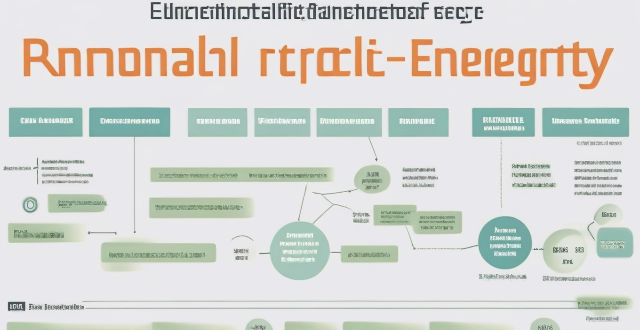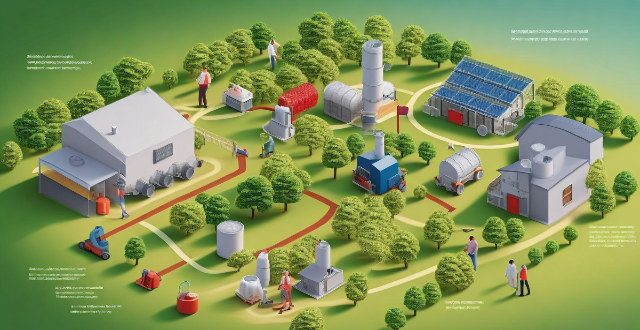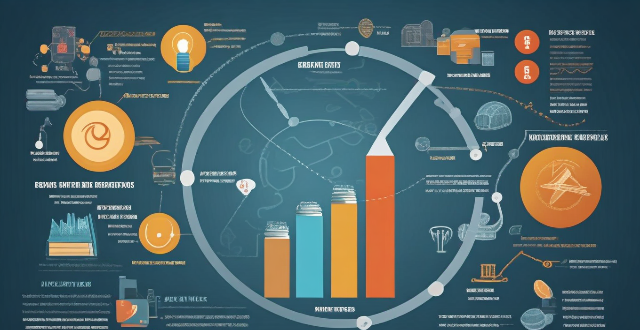Development Renewable

How do climate policies influence renewable energy development and adoption ?
Climate policies play a crucial role in shaping the trajectory of renewable energy development and adoption. These policies are designed to mitigate the effects of climate change by reducing greenhouse gas emissions and promoting the use of clean energy sources. In this article, we will explore the various ways in which climate policies influence renewable energy development and adoption. Governments around the world have implemented a range of incentives and subsidies to encourage the development and adoption of renewable energy sources. These include feed-in tariffs, renewable portfolio standards, tax credits and exemptions, and research and development funding. Carbon pricing mechanisms, such as carbon taxes and cap-and-trade systems, are designed to put a price on carbon emissions. By making fossil fuels more expensive relative to renewable energy sources, these policies create an economic incentive for businesses and consumers to switch to cleaner energy alternatives. Governments also impose regulatory measures to promote renewable energy development and adoption. These include building codes and standards, energy efficiency standards, and renewable energy targets. Public awareness and education campaigns aim to increase public awareness about the benefits of renewable energy and encourage its adoption. These campaigns promote energy conservation, support local renewable energy projects, and raise awareness about the environmental and economic benefits of clean energy sources.

How do renewable energy policies influence innovation and technology development ?
Renewable energy policies are crucial for driving innovation and technology development in the clean energy sector. These policies provide incentives for research, investment, and deployment, creating a favorable environment for technological advancements and innovation. Government support and funding, regulatory frameworks, market incentives, and collaboration and partnerships are all essential factors that influence innovation and technology development in this sector. By providing financial assistance, setting standards and requirements, creating demand for clean energy solutions, and fostering collaboration between different stakeholders, renewable energy policies help to accelerate the development of new technologies and improve existing ones. As we continue to face challenges related to climate change and energy security, it is essential that we continue to invest in renewable energy solutions and support policies that encourage innovation and progress in this field.

How can a carbon tax be used to encourage the development of renewable energy sources ?
A carbon tax is a fee on burning carbon-based fuels that aims to reduce emissions by making fossil fuels more expensive, encouraging the use of renewable energy sources. It directly impacts prices, changes consumer behavior, provides economic incentives for renewables, creates market signals for businesses, and supports regulatory frameworks. This leads to increased investment in research and development, subsidies, long-term planning security, innovation, and stricter efficiency standards, all of which contribute to the development of renewable energy sources.

What steps can governments take to promote renewable energy jobs ?
Governments can promote renewable energy jobs through various policies and incentives. They can implement regulations like Renewable Portfolio Standards, Feed-in Tariffs, Net Metering Laws, and Renewable Energy Certificates. Financial incentives such as tax credits, grants, loans, and investment tax exemptions can also be provided. Governments can support research and development by funding studies, collaborating with academia, forming public-private partnerships, and supporting startups. Education and training programs, infrastructure development, streamlining permitting processes, encouraging local production and consumption, and international cooperation are other steps that can be taken to promote renewable energy jobs.

How can citizens support renewable energy development in their community ?
Renewable energy sources are crucial for reducing carbon footprint and mitigating climate change. Citizens can support renewable energy development in their community by participating in local government initiatives, investing in renewable energy, advocating for change, supporting local businesses, educating themselves and others, using renewable energy products, and volunteering and donating.

What is the current state of renewable energy research and development ?
Renewable energy research and development (R&D) is a rapidly evolving field that aims to create sustainable alternatives to traditional fossil fuels. The current state of renewable energy R&D can be characterized by several key trends: ### **Advances in Technology** - Solar energy research focuses on improving the efficiency of photovoltaic cells and concentrated solar power systems. - Wind energy technology is advancing with the development of offshore wind turbines and material innovations for turbine blades. - Hydropower research explores ways to harness energy from small streams and rivers without ecological harm, as well as improvements to pumped storage systems. - Geothermal energy is expanding beyond natural hotspots through enhanced geothermal systems and binary cycle power plants. ### **Integration with Grid Systems** - Smart grids enable better management of consumer demand and integrate distributed energy resources like rooftop solar panels and small wind turbines. - Energy storage solutions, such as battery technologies and pumped hydro storage, are being refined for improved efficiency and environmental impact. ### **Policy and Economic Drivers** - Government incentives like tax credits and feed-in tariffs encourage renewable energy adoption. - Carbon pricing mechanisms, including emissions trading schemes and carbon taxes, create financial incentives for companies to reduce their greenhouse gas emissions. ### **Environmental Impact and Sustainability** - Lifecycle analysis examines the manufacturing processes and end-of-life management of renewable energy equipment to minimize environmental footprint. - Biodiversity conservation efforts aim to mitigate the impact of renewable energy infrastructure on wildlife habitats and ecosystems. As technological innovation, grid integration advancements, supportive policies, and consideration for environmental impact continue, renewable energy is expected to play an increasingly vital role in global energy supply while helping to mitigate climate change.

What are the current trends in renewable energy policies globally ?
The global community is increasingly prioritizing renewable energy policies as part of efforts to combat climate change and reduce carbon emissions. Governments are offering financial incentives, setting ambitious targets for renewable energy consumption, promoting energy efficiency, and encouraging private sector investment in clean energy projects. These trends reflect a worldwide commitment to creating a more sustainable future through the adoption of renewable energy sources.

How do international climate agreements influence national policies on renewable energy ?
International climate agreements significantly shape national renewable energy policies by setting targets, offering financial aid and technology transfer, promoting innovation and collaboration, and creating market opportunities. This influence is evident in countries' ambitious renewable energy goals, their participation in global initiatives, and the growth of related industries. Such concerted efforts are crucial for achieving a sustainable, low-carbon future.

How can governments support the development and implementation of sustainable energy solutions ?
Governments can support sustainable energy solutions through clear policies, financial incentives, R&D, education, infrastructure development, international cooperation, market-based mechanisms, and demonstration projects.

What role do renewable energy sources play in climate change adaptation ?
Renewable energy sources play a crucial role in climate change adaptation by reducing greenhouse gas emissions, promoting sustainable development, and enhancing energy security. By transitioning from fossil fuels to renewable energy sources, we can significantly reduce carbon dioxide emissions, which are a major contributor to global warming and climate change. Renewable energy sources are sustainable because they rely on natural processes that replenish themselves over time, unlike non-renewable resources like coal and oil. By using renewable energy sources, we can promote sustainable development that meets the needs of the present without compromising the ability of future generations to meet their own needs. Renewable energy sources provide a diversified energy mix that reduces dependence on imported fossil fuels, enhancing energy security for countries around the world.

Can renewable energy sources effectively replace fossil fuels ?
- Renewable energy sources are sustainable and produce fewer emissions than fossil fuels. - Intermittency, storage, and cost are challenges to the adoption of renewable energy. - Grid integration, energy storage advancements, and government policies can help overcome these challenges.

What are the key considerations for integrating renewable energy sources into urban designs ?
Key considerations for integrating renewable energy sources into urban designs include assessing available renewable energy sources, prioritizing energy efficiency, ensuring grid connectivity, involving the community, and considering financial viability.

What role do renewable energies play in achieving climate objectives ?
Renewable energies play a crucial role in achieving climate objectives by reducing greenhouse gas emissions, promoting energy security, and driving economic growth. By transitioning to renewable sources such as solar, wind, hydro, and geothermal power, we can reduce the overall carbon footprint of our energy systems and mitigate the effects of climate change. Renewable energies also promote energy security by diversifying energy sources, increasing local energy production, and stabilizing energy prices. Additionally, the transition to renewable energies creates job opportunities, stimulates innovation, and attracts investment, contributing to economic growth. Overall, prioritizing the development and adoption of renewable energy technologies is essential for achieving a cleaner, more sustainable future.

What role do renewable energy sources play in combating climate change ?
Renewable energy sources play a crucial role in combating climate change by reducing greenhouse gas emissions, promoting sustainable development, creating job opportunities, and enhancing energy security. Solar, wind, hydropower, and other renewable energy sources are clean and sustainable alternatives to fossil fuels. By investing in these sources, we can slow down the rate of climate change and create a cleaner, more sustainable future for all.

What is the role of renewable energy in achieving climate commitments ?
Renewable energy is a key component of global efforts to reduce greenhouse gas emissions and mitigate climate change, contributing to environmental protection, economic prosperity, and social well-being. It reduces carbon footprint, enhances energy security, stimulates economic growth, improves public health, supports sustainable development, advances technology and innovation, and contributes to international cooperation. The transition to renewable energy is crucial for meeting climate commitments and ensuring a sustainable future.

How can climate finance be leveraged to support renewable energy projects ?
Climate finance plays a crucial role in supporting renewable energy projects. Here are some ways to leverage it: 1. Public-Private Partnerships (PPPs) can be used to attract private investment into renewable energy projects. 2. Green Bonds can be issued to fund environmentally friendly projects such as solar and wind farms. 3. Carbon Pricing Mechanisms can generate revenue that can be invested in renewable energy projects. 4. International Climate Finance Initiatives can provide funding for renewable energy projects in developing countries. 5. Crowdfunding Platforms offer another way to raise funds for renewable energy projects. By using a combination of these strategies, we can accelerate the transition towards a more sustainable future.

What is the impact of renewable energy on emission reduction goals ?
The shift to renewable energy sources such as solar, wind, hydro, and geothermal power is vital for reducing greenhouse gas emissions and achieving global emission reduction goals. This transition brings multiple benefits including decreased reliance on fossil fuels, improved air quality, enhanced energy security, economic stimulation through job creation and long-term cost savings, technological innovation leading to reduced costs, and significant contributions to mitigating climate change. As technology advances and economies of scale are achieved, renewable energy's role in facilitating further progress toward emission reduction objectives will become increasingly important.

What is the role of renewable energy in achieving carbon neutrality ?
Renewable energy is crucial for achieving carbon neutrality, which involves balancing carbon emissions with offsetting actions. By reducing reliance on fossil fuels and greenhouse gas emissions, renewable sources such as wind and solar contribute significantly to this goal. Renewable energy also promotes energy efficiency, economic growth, and energy independence while mitigating climate change impacts. It supports sustainable development goals and fosters innovation and public engagement in environmental issues. The transition to renewable energy offers long-term environmental benefits, making it essential for a sustainable future with stable climates, thriving economies, and healthier societies.

How do renewable energy policies vary across different countries and regions ?
Renewable energy policies globally are shaped by economic, environmental, and political factors. Europe leads in renewable adoption with Germany's Energiewende, Spain's feed-in tariffs (FiTs), and Denmark aiming for fossil fuel independence. North America uses state-level RPS, tax incentives, and market-driven approaches. Asia sees rapid growth with China's government support and India's ambitious targets. Africa focuses on access to electricity through projects like South Africa's REIPPPP. Latin America balances economic development and sustainability, with Brazil expanding into solar and Mexico deregulating its electricity market. Policies include FiTs, quota systems, auctions, and financial incentives, varying by region's resources and priorities.

How can Smart Grid Technology help in managing renewable energy sources ?
Smart grid technology is crucial for managing renewable energy sources, enabling their integration into the existing power system and improving efficiency, reliability, and sustainability. It achieves this by optimizing energy consumption, managing demand response, predicting maintenance, self-healing capabilities, integrating energy storage, developing microgrids, real-time monitoring, and data analytics. As renewable energy grows in importance, smart grid technology will become increasingly vital in integrating these sources into our power systems.

How will the shift towards electric vehicles impact energy transition goals ?
Electric vehicles play a crucial role in achieving energy transition goals by reducing greenhouse gas emissions, promoting renewable energy sources, and improving energy efficiency. They produce zero tailpipe emissions, leading to improved air quality in urban areas. The increased demand for renewable energy to power EVs drives the development of solar and wind technologies. EVs are more energy-efficient than traditional vehicles and can help reduce energy waste through smart charging systems. However, challenges such as infrastructure development and battery production must be addressed, while opportunities like job creation and technological innovation should be capitalized on to accelerate progress towards a sustainable future.

What impact does climate change legislation have on renewable energy development ?
Climate change legislation significantly influences renewable energy development by providing financial incentives, establishing mandated targets, supporting research and infrastructure, creating consumer awareness, fostering international cooperation, implementing regulations, setting environmental standards, and promoting economic growth through job creation. These measures collectively drive the energy sector towards sustainability and a low-carbon future.

How can renewable energy policies be designed to maximize social and environmental benefits ?
Renewable energy policies are crucial for transitioning towards a sustainable future. To maximize social and environmental benefits, these policies must be carefully designed, considering various factors such as economic impacts, technological advancements, public acceptance, and environmental sustainability. Here's a detailed guide on how renewable energy policies can be structured to achieve the best outcomes: ## 1\. Setting Clear and Achievable Goals Clear objectives are fundamental for effective policymaking. These goals should be specific, measurable, achievable, relevant, and time-bound. ## 2\. Promoting Technological Innovation and Research Investments in research and development (R&D) are vital for advancing renewable technologies. Incentivize private sector R&D, provide public funding for research, and foster collaboration between academia and industry. ## 3\. Encouraging Public Participation and Awareness Engagement from the public is essential for the successful implementation of renewable energy policies. Educational campaigns, community involvement programs, and feedback mechanisms are key components. ## 4\. Implementing Economic Incentives Make renewable energy options more attractive through financial incentives such as feed-in tariffs, tax credits, and subsidies. ## 5\. Strengthening Legal and Regulatory Frameworks Establish clear regulations that support renewable energy adoption, including net metering laws, renewable portfolio standards, and building codes. ## 6\. Addressing Environmental Concerns Ensure that renewable energy projects minimize environmental impacts through environmental impact assessments, habitat protection measures, and sustainable land use practices. ## 7\. Supporting Infrastructure Development Invest in the necessary infrastructure to facilitate the growth of renewable energy, including transmission networks, storage solutions, and smart grids. ## 8\. Fostering International Cooperation Global collaboration is key to tackling climate change effectively. Facilitate the transfer of renewable energy technologies across borders, collaborate on international research efforts, and participate in treaties aimed at reducing carbon emissions and promoting renewable energy use globally.

What impact do energy storage solutions have on the economics of renewable energy ?
Energy storage solutions significantly impact renewable energy economics by addressing variability and unpredictability. They enhance grid stability, reduce costs, and increase efficiency, thus making renewable energy more viable. With ongoing technological advancements, energy storage will continue to play a crucial role in integrating renewable energy into power grids and achieving global decarbonization goals.

What impact does decentralized renewable energy have on the electric grid ?
Decentralized renewable energy sources, such as solarDecentralized renewable energy sources, such as solarbines, have a significant such as solar panels and wind turbines, have a significant impact on the electric grid. They reduce dependence on centralized generation, affect grid stability and reliability, require infrastructure changes, have economic implications, provide environmental benefits, and empower communities. As technology advances and costs decrease, decentralized renewable energy is expected to be increasingly adopted worldwide, offering numerous benefits in terms of sustainability, development, and community control over energy sources.

What are the benefits of using renewable energy sources for improving energy efficiency ?
Renewable energy sources offer multiple benefits, includingRenewable energy sources offer multiple benefits, including improved air quality, cost savings Renewable energy also provides stable energy prices and reduces dependence on imported fossil fuels, leading to greater energy security. Additionally, the development and deployment of renewable energy technologies create jobs and drive innovation and research in new technologies. Overall, investing in renewable energy is crucial for a sustainable future.

How is renewable energy affecting the traditional energy market ?
Renewable energy sources are having a significant impact on the traditional energy market, affecting pricing, market share, job creation, and environmental concerns. The increased efficiency and reduced installation costs of renewable technologies have made them more competitive with traditional energy sources, leading to declining electricity prices overall. Additionally, the growing demand for renewable energy sources has led to an increase in their market share, particularly for solar and wind power. The transition to renewable energy is also creating new job opportunities across various sectors of the economy, while addressing environmental concerns associated with fossil fuel consumption.

How has the rise of renewable energy affected consumer preferences and buying habits ?
The rise of renewable energy has significantly influenced consumer preferences and buying habits, including increased awareness and interest in sustainability, changes in purchasing decisions towards energy-efficient products and electric vehicles, support for green initiatives, a shift towards renewable energy service providers, and adoption of smart technology.

What is the role of renewable energy in combating climate change ?
The text discusses the role of renewable energy in combating climate change. It defines renewable energy as derived from natural processes that are constantly replenished, including solar, wind, hydroelectric, geothermal, and biomass energy. The importance of renewable energy is highlighted by its low carbon emissions, sustainability, and economic benefits. Renewable energy combats climate change by reducing greenhouse gas emissions, diversifying the energy mix, promoting energy efficiency, stimulating innovation, and enhancing environmental stewardship. The transition to renewable energy presents economic opportunities and promotes innovation, with a profound impact on slowing climate change.

How efficient is wind energy compared to other renewable sources ?
The efficiency of wind energy is influenced by factors such as capacity factor, technological advancements, and site specificity. Compared to other renewable sources like solar, hydropower, geothermal, biomass, and tidal/wave energy, wind energy has a relatively high capacity factor ranging from 35% to 45%. Technological improvements have increased the efficiency of wind turbines over the years, making them more productive. However, the efficiency of wind farms is highly dependent on the location, with optimal sites achieving higher efficiency rates. In conclusion, wind energy compares favorably to other renewable sources in terms of efficiency, but the choice between different renewable energies often depends on local conditions, economic factors, and technological advancements.